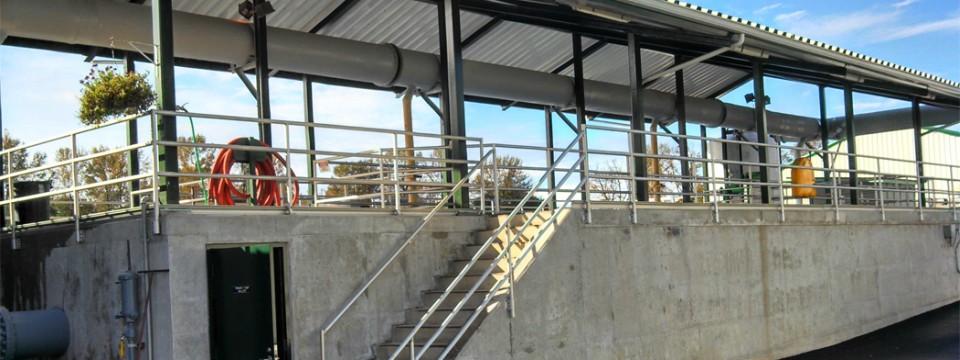Project Highlights
Location: Monroe, Washington
Industry: Industrial
Services Used: Energy Efficiency Contracting,
Climate: Humid & Cold
Topic: Efficiency, Cost-Saving,

Challenge
To ensure the Wastewater Treatment Plant’s (WWTP) ability to effectively serve the community, the City of Monroe sought to replace aging equipment; quantify operational and energy savings opportunities; increase capacity; avoid service, maintenance and capital costs; reduce energy use; and maximize system life and reliability. “Our main issue was equipment obsolescence,” said John Lande, manager, City of Monroe. “We had an air leak that was reducing efficiency and wanted to regain capacity lost with an earlier repurposing of our secondary clarifier. We needed to replace equipment and components.”
Solution
Utilizing the State of Washington Energy Savings Performance Contracting (ESPC) program administered by the Department of Enterprise Services, the City selected Trane as its ESCO (Energy Services Company) to oversee design, engineering, construction, and equipment installation. After initial discussions with the City, Trane® Building Advantage® engaged the extensive WWTP planning and design experience of BHC Consultants. The team completed an Investment Grade Audit, which included interviews with WWTP staff who were instrumental in shaping the project scope, and proposed upgrades and renovations to various processes and systems. Working in collaboration, the City, Trane and BHC prioritized the proposed energy conservation measures. “We worked with Trane on Phase I of the WWTP upgrade and were familiar with plant operations,” said Tom Giese, professional engineer, BHC Consultants. “The project scope included some items deferred in Phase I, as well as additional upgrades.”
Increasing treatment capacity
Rather than undergoing the expense and energy costs of installing another digester to increase treatment capacity, and improve solids destruction and bio-solids quality, the City installed a new disc thickener with associated pumps and equipment. Partially dewatering sludge prior to digestion increases solids retention time by decreasing volume of the sludge to be digested. The unused grit chamber was converted to waste activated system (WAS) storage with aeration supplied to the new WAS tank by coarse bubble diffusers connected to new digester blowers. The WAS storage tank was covered with aluminum panels and ventilated. “Installation of the new disc thickener benefits the City in ways they might not have been expecting,” said Giese. “The sludge stays in the digester longer, there is less to dewater, less energy used, and less to haul away.”
Extending equipment life, improving efficiency
To improve efficiency, worn and non-functional components of the primary clarifier were replaced, and repairs were completed on the failing cross collector drive mechanisms. The scum pumps were replaced with progressive cavity scum pumps with variable speed drives, reducing energy use. To improve clarifier reliability and performance, a two-motor drive system made with high molecular plastic and stainless steel components replaced the one-motor system driving the main collector and cross collector.
Replacing aging systems, repurposing assets
To avoid the high cost of building additional digester capacity, the secondary clarifier, performing dual process functions of secondary clarification and WAS thickening, was set back to its intended purpose of providing plant capacity. At the end of its life, the existing clarifier was replaced with a new tapered suction header mechanism. The existing fiberglass dome cover was removed and aluminum guardrails installed. The secondary clarifier launders, walls and floors were cleaned and coated with 100 percent solids ultra-high-build epoxy coating to extend service life. Leaking aeration air piping in the mixed liquor channel and isolation butterfly valves upstream of the channel diffuser drops were replaced with stainless steel piping to reduce energy loss and improve process efficiency.
Optimizing performance, integrating controls
In a state of failure, the four aging rotary lob digester blowers were replaced with two energy efficient hybrid blowers. The new blowers allow for variable airflow control to improve performance and efficiency of the digestion process, and provide increased aeration capacity critical to the aerobic digestion process. Integration of controls was also completed to allow operation of the blowers based on measurement of oxidation-reduction potential, replacement of piping and valves, addition of variable frequency drives, and control programming modifications.
Refurbishing structure, avoiding capital costs
With early signs of corrosion present in the structural members of the dewatering building, a custom hood over the belt filter press was installed to divert moisture laden air away from the building. The hood was designed to improve the collection and ventilation of corrosive water vapor and gasses, which cause degradation of the roof and supporting structure, helping to extend the life of the building and avoid capital cost.
Results
Utilizing the State of Washington Energy Savings Performance Contracting (ESPC) program administered by the Department of Enterprise Services, the City of Monroe Wastewater Treatment Plant worked with Trane to address and prioritize items on the City’s Comprehensive Sewer Plan, replacing equipment nearing end of life expectancy, and quantifying operational and energy savings opportunities. The upgrades have increased the treatment plant capacity and extended the life of existing assets through refurbishment and repurposing. With more efficient equipment and improving process control, system life and reliability have been maximized. Energy costs have also been reduced, with the project on track to exceed guaranteed utility reductions totaling 86,652 kWh/year, for an annual savings of $6,074. The project has reduced maintenance and operational costs $8,000 per year, and is helping the plant to avoid planned capital replacement costs totaling more than $5,200,000 in the next ten years.
“Although we will be meeting the guaranteed energy savings, it isn’t the main driver for using the ESPC,” said Lande. “The ESPC process fast tracks everything. Without it, the project would have taken two and a half years. We did it in less than a year. The project was done at a guaranteed cost without change orders, which helped budgeting. Plus, we were able to select the capable contractors and specific equipment, which best fit the City’s needs.
“Trane’s number one goal was to make sure we were satisfied. They oversaw the entire project, handled the problems, asked questions to find out what the City wanted, and made it happen.”
































































































